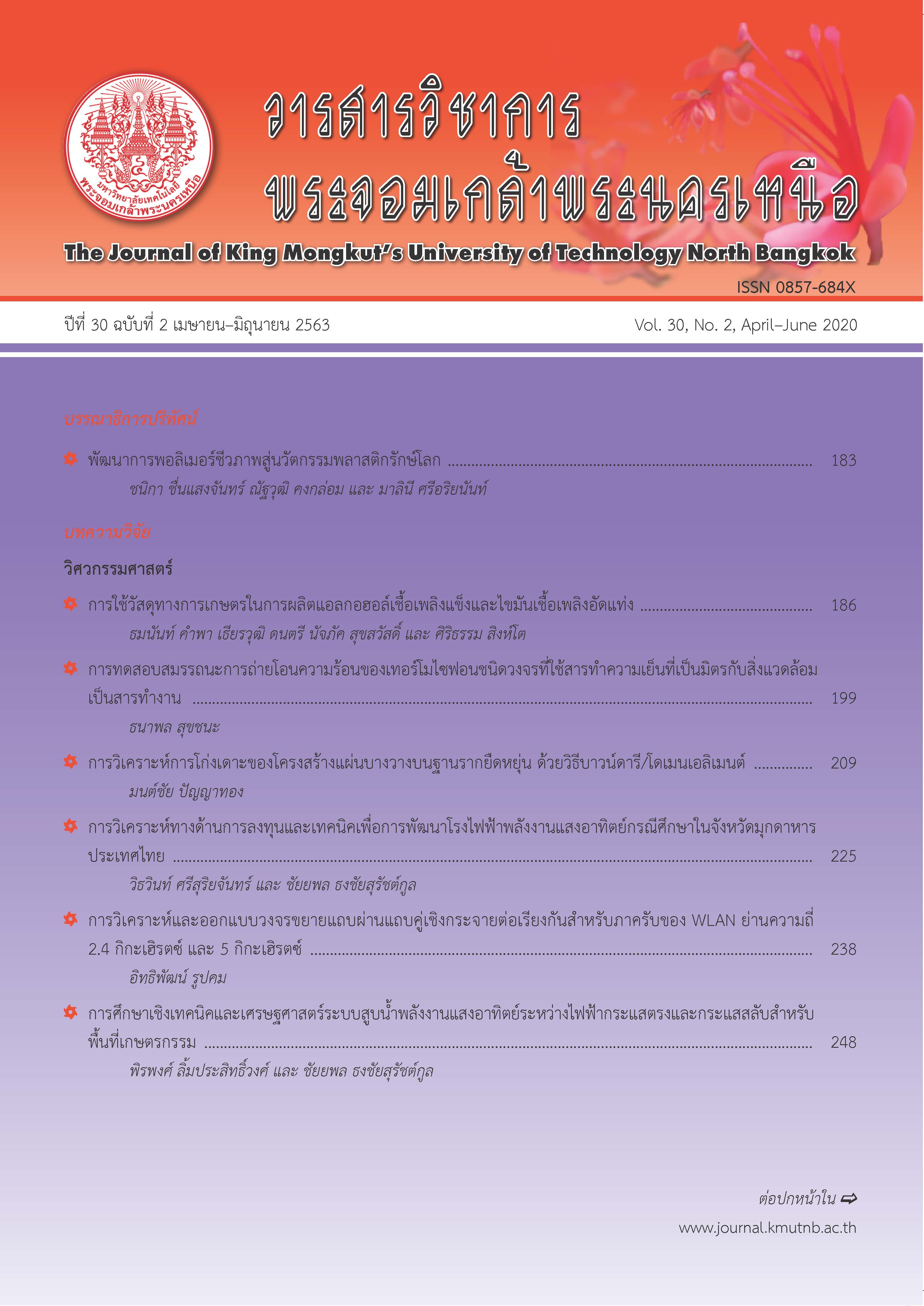คุณสมบัติของจีโอพอลิเมอร์คอนกรีตพรุนจากเถ้าลอยแคลเซียมสูงผสมกากแคลเซียมคาร์ไบด์
Main Article Content
บทคัดย่อ
งานวิจัยนี้มีจุดประสงค์เพื่อศึกษาสมบัติของจีโอพอลิเมอร์คอนกรีตพรุน โดยศึกษาการใช้วัสดุ 2 ชนิด ได้แก่ เถ้าลอยและกากแคลเซียมคาร์ไบด์เป็นวัสดุตั้งต้นและวัสดุเร่งการก่อตัวในการพัฒนาสมบัติของจีโอพอลิเมอร์คอนกรีตพรุน ใช้กากแคลเซียมคาร์ไบด์แทนที่ในเถ้าลอยร้อยละ 0, 10, 20 และ 30 โดยน้ำหนักวัสดุประสาน โดยใช้สารละลายโซเดียมซิลิเกตและสารละลายโซเดียมไฮดรอกไซด์เป็นตัวทำปฏิกิริยาในส่วนผสม และใช้อัตราส่วนสารละลายโซเดียมซิลิเกตต่อสารละลายโซเดียมไฮดรอกไซด์เท่ากับ 2.0 และอัตราส่วนของมวลรวมหยาบต่อวัสดุประสานเท่ากับ 8.0 และอัตราส่วนของเหลวต่อวัสดุประสานเท่ากับ 0.50 ทุกอัตราส่วนผสม โดยศึกษาปัจจัยของความเข้มข้นของสารละลายโซเดียมไฮดรอกไซด์เท่ากับ 5, 10 และ 15 โมลาร์ โดยทำการทดสอบกำลังอัด กำลังดัด ความหนาแน่น อัตราส่วนช่องว่างและสัมประสิทธิ์การซึมผ่านของน้ำของจีโอพอลิเมอร์คอนกรีตพรุน ผลการทดสอบพบว่า การใช้กากแคลเซียมคาร์ไบด์แทนที่เถ้าลอยสามารถปรับปรุงกำลังอัดและกำลังดัดของจีโอพอลิเมอร์คอนกรีตพรุนได้ โดยเฉพาะการแทนที่กากแคลเซียมคาร์ไบด์ในเถ้าลอยร้อยละ 10 ผสมกับของความเข้มข้นของสารละลายโซเดียมไฮดรอกไซด์เท่ากับ 15 โมลาร์ อัตราส่วนของเหลวต่อวัสดุประสานเท่ากับ 0.50 สามารถให้กำลังอัดของจีโอพอลิเมอร์คอนกรีตพรุนสูงสุดที่อายุการบ่ม 28 วัน เท่ากับ 79.41 กิโลกรัมต่อตารางเซนติเมตร นอกจากนี้ยังพบว่าค่าความพรุนที่อายุการบ่ม 28 วัน อยู่ระหว่าง 30.80–32.65% และค่าสัมประสิทธิ์การซึมผ่านน้ำที่อายุการบ่ม 28 วัน มีค่าอยู่ระหว่าง 2.17–3.16 เซนติเมตร/วินาที
Article Details
บทความที่ลงตีพิมพ์เป็นข้อคิดเห็นของผู้เขียนเท่านั้น
ผู้เขียนจะต้องเป็นผู้รับผิดชอบต่อผลทางกฎหมายใดๆ ที่อาจเกิดขึ้นจากบทความนั้น
เอกสารอ้างอิง
[2] T. Phoo-ngernkham, S. Hanjitsuwan, C. Suksiripattanapong, J. Thumrongvut, J. Suebsuk, and S. Sookasem, “Flexural strength ofnotched concrete beam filled with alkali activated binders under different types of alkali solutions,” Construction and Building Materials, vol. 127, pp. 673–678, 2016.
[3] J. Davidovits, “Geopolymers: Inorganic polymeric new materials,” Journal of Thermal Analysis, vol. 37, no. 8, pp. 1633–1656, 1991.
[4] S. Pangdaeng, T. Phoo-ngernkham, V. Sata, and P. Chindaprasirt, “Influence of curing conditions on properties of high calcium fly ash geopolymer containing Portland cement as additive,” Materials & Design, vol. 53, pp. 269–274, 2014.
[5] P. Chindaprasirt, T. Chareerat, and V. Sirivivatnanon, “Workability and strength of coarse high calcium fly ash geopolymer,” Cement and Concrete Composites, vol. 29, no. 3, pp. 224–229, 2007.
[6] S. Hanjitsuwan, T. Phoo-ngernkham, L.Y. Li, N. Damrongwiriyanupap, and P. Chindaprasirt, “Strength development and durability of alkaliactivated fly ash mortar with calcium carbide residue as additive,” Construction and Building Materials, vol. 162, pp. 714–723, 2018.
[7] S. Hanjitsuwan, T. Phoo-ngernkham, and N. Damrongwiriyanupap, “Comparative study using portland cement and calcium carbide residue as a promoter in bottom ash geopolymer mortar,” Construction and Building Materials, vol. 133, pp. 128–134, 2017.
[8] T. Phoo-ngernkham, P. Chindaprasirt, V. Sata, S. Pangdaeng, and T. Sinsiri, “Properties of high calcium fly ash geopolymer containing portland cement additive,” International Journal of Minerals, Metallurgy and Materials, vol. 20, no. 2, pp. 214–220, 2013.
[9] C. Namarak, W. Tangchirapat, and C. Jaturapitakkul, “Bar-concrete bond in mixes containing calcium car bide residue, fly ash and recycled concrete aggregate,” Cement and Concrete Composites, vol. 89, pp. 31–40, 2008.
[10] N. Makaratat, C. Jaturapitakkul, C. Namarak, and V. Sata, “Effects of binder and CaCl2 contents on the strength of calcium carbide residue-fly ash concrete,” Cement and Concrete Composites, vol. 33, pp. 436–443, 2011.
[11] S. Horpibulsuk, C. Phetchuay, A. Chinkulkijniwat, and A. Cholaphatsorn, “Strength development in silty clay stabilized with calcium carbide residue and fly ash,” Soils and Foundations, vol. 53, no. 4, pp. 477–486, 2013.
[12] Standard test method for compressive strength of cylindrical concrete specimens, Annual Book of ASTM Standard ASTM C39, 2001.
[13] Standard test method for flexural strength of concrete (using simple beam with third-point loading), Annual Book of ASTM Standard ASTM C78, 2010.
[14] Standard test method for density and void content of freshly mixed pervious concrete, Annual Book of ASTM Standard ASTM C1688/C1688-08, 2013.
[15] Y. Zaetang, A. Wongsa, V. Sata, and P. Chindaprasirt, “Use of lightweight aggregates in pervious concrete,” Construction and Building Materials, vol. 48, pp. 585–591, 2013.
[16] A. Palomo, M. T. Blanco-Varela, M. L. Granizo, F. Puertas, T. Vazquez, and M.W. Grutzeck, “Chemical stability of cementitious materials based on metakaolin,” Cement and Concrete Research, vol. 29, no. 7, pp. 997–1004, 1999.
[17] Z. Zuhua, Y. Xiao, Z. Huajun, and C. Yue, “Role of water in the synthesis of calcined kaolinbased geopolymer,” Applied Clay Science, vol. 43, no. 2, pp. 218–223, 2009.
[18] W. K. W. Lee and J. S. J. Van Deventer, “The effects of inorganic salt contamination on the strength and durability of geopolymers,” Colloids and Surfaces A: Physicochemical and Engineering Aspects, vol. 211, no. 2–3, pp. 115–126, 2002.
[19] Report on Pervious Concrete, American Concrete Institute Standard ACI 522R-10, 2010.
[20] B. Debnath and P.P. Sarkar, “Permeability prediction and pore structure feature of pervious concrete using brick as aggregate,” Construction and Building Materials, vol. 213, pp. 643–651, 2019.

